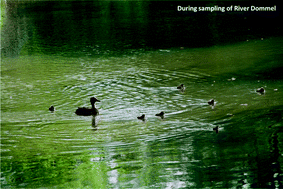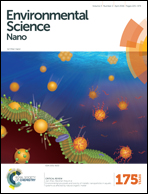Towards validation of the NanoDUFLOW nanoparticle fate model for the river Dommel, The Netherlands†
Abstract
It is generally acknowledged that fate models for engineered nanoparticles (ENPs) hardly can be validated, given present limitations in analytical methods available for ENPs. Here we report on progress towards validation of the spatially resolved hydrological ENP fate model NanoDUFLOW, by comparing measured and modeled concentrations of <450 nm Ce, Al, Ti and Zr-based particles for river Dommel (NL), as measured by Asymmetric Flow-Field-Flow Fractionation (AF4) coupled to ICP-MS. NanoDUFLOW simulates advection, aggregation–sedimentation, resuspension, dissolution and burial for singular ENPs, 5 classes of ENP homoaggregates and 25 classes of heteroaggregates, dynamically in space and time, and uses actual hydrological data of the river, 5 tributaries and a waste water treatment plant effluent. Validation for Ce particles was very good, whereas for Al, Ti and Zr particles, reasonable results were obtained. Model output was relatively insensitive to the attachment efficiency parameter, due to fast heteroaggregation. We argue that although the results cannot be taken as formal validation of singular <100 nm ENP behavior, they probably validate the reflection of that behavior on the level of natural and ENP-inclusive aggregate transport in the modeled system.


 Please wait while we load your content...
Please wait while we load your content...